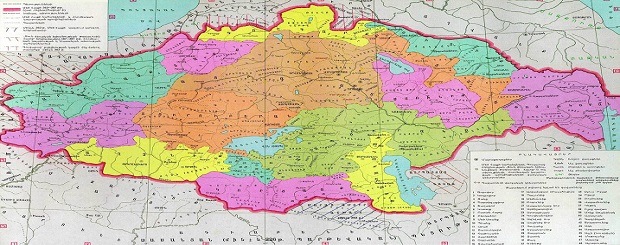
History of the Ancestors: the six-pointed star in the history of Armenia…
The Armenian Wheel of Eternity, the most iconic and important symbol among many ancient Armenian symbols.
In some cases, Armenians depicted the Wheel of Eternity inside a hex-pointed star.
Today, most people associate the hexagonal star (hexagram) with the Jewish star of David (Magen David), as it is a modern symbol of Jewish identity and Judaism.
In 1948. He was even adopted on the official flag of Israel. According to Wikipedia: “Its use as a symbol of the Jewish community dates back to the 17th century.”
However, like many other aspects of Armenian culture, not much has been written about the Armenian use of a hexagram. Although its use in science, art, architecture, decoration, and even religious purposes has been widespread throughout history.
Historically Armenians are experienced mathematicians, architects and craftsmen, and geometry has always been very special to Armenians.
Ancient Armenians had a sophisticated knowledge of astronomy and could predict astrological events.
It is known that the oldest known observatories are located in Armenia, dating back to 4200 BC, for example Karahunj.
Observatory 2800 to n. e. Metsamor allowed Armenian ancestors to develop geometry to such a level that they could measure distances, latitudes and longitudes, know about the real shape of the earth and predict solar and lunar eclipses 1000 years before the Egyptians.
Armenian architecture with geometric parallel lines combines bearing structures with mathematical accuracy.
The geometry of Armenian architecture has stood the test of time, preserving many ancient buildings in the region dominated by war, poverty and natural disasters.
Cities and temples of fortresses that were excavated in Armenia, some of them dating back to 7,000 years or more, demonstrate a remarkable understanding of the use of geometry in the construction of sacred buildings, using a complex system of squares, rectangles, circles, polyangles with intersecting patterns.
Geometry arises from the study of natural laws. With such knowledge, you can build structures, create devices and predict astrological events. Such geometric shapes are considered magical ancient.
Without geometry you can’t build anything, and knowledge of it has become the key to survival and has been considered the key to unlocking the secrets of the universe. This love of creation/construction allowed the early Armenians to appreciate geometric shapes and symbols, giving them a prominent place in Armenian culture.
Among many symbols, Armenians used a six-pointed star for architectural purposes. The early Armenians believed that the symbol possessed magical powers and included it in architecture, astronomy and sacred art.
This is confirmed by the numerous Armenian churches, whose foundations are built in the shape of a hex-pointed star.
A hexagram was also used, to support the dome, or used simply as a sacred decoration protecting the church.
The first and most important Armenian cathedral of Echmiadzin (303). n. e. , built by the founder of Christianity in Armenia) is actually decorated with many ornamental hexagrams.
Another example can be seen at the tomb of the Armenian prince of the Hasan-Jhalalyan Khachen dynasty (1214). ) at the Gandzasar Church of Artsakh. (see. lower)
Perhaps the most famous example of architectural use of a hexagram can be seen in the Armenian Church of the 12th century, in the Church of St. James in Jerusalem.
Where hexagram-shaped arches support the dome. Similar dome arcs in the shape of a hex-pointed star can be found throughout ancient Armenia.
To name a few; the excellent craftsmanship of the 13th-century Khorakertsk Monastery dome. Horanashat Monastery (see. Pictures below
The fact that Armenians have been familiar with this symbol since immortal times became clear again when the ancient known image of a hex-pointed star (dating to the 3rd millennium BC) was unearthed in the Ashtarak mound in Nerkin Navra (in Armenia). This is confirmed by radio carbon analysis of artifacts conducted in laboratories of Germany and the United States.
The handle of a dagger dug in the burial of Ashtarak (Nerkin-Naver) (3rd millennium BC, Armenia)
Geometry, in particular, has a long history in Armenian art, religion, as well as sciences. Although the use of hexagrams has been significant throughout Armenia’s history, Armenian culture contains many other geometric shapes and symbols.
Geometry is, after all, related to Armenian culture. For example, the eight-pointed Armenian star deserves, which was already mentioned on the pages of the website Outside the Line. (see link post: The genealogy of the octopus cross and octopus star – From Armenia to Europe
The Armenian Wheel Of Eternity peopleofar
“STAR OF DAVID” OR A RELIGIOUS SYMBOL STOLEN FROM ARMENIANS

Marble tombstone of the Grand Duke of Armenia Hasan Jalal Vakhtangyan (1214-1261)
https://www.facebook.com/groups/826809288544668/user/61552210133112/
